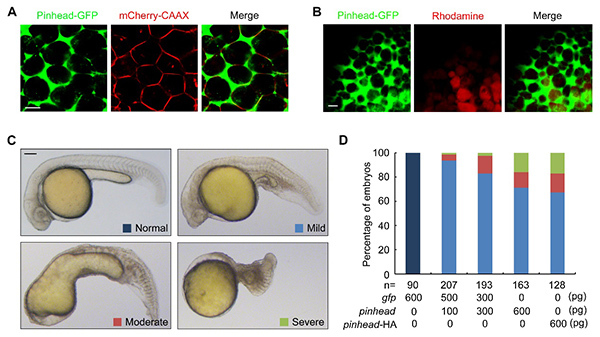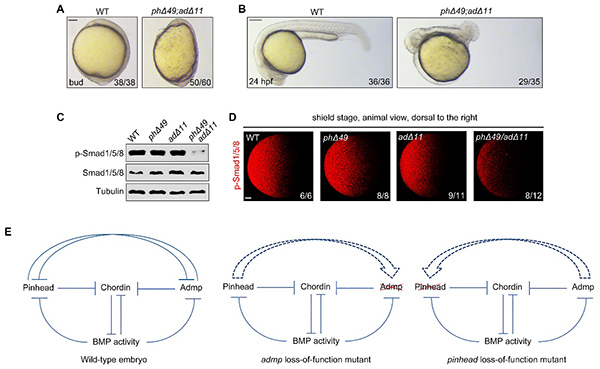
In zebrafish embryo, most individual blastomeres are not restricted to particular fates until the early gastrula stage. At the onset of gastrulation, individual blastomeres adopt particular fates that are predictable based on their positions. For example, precursors for different mesodermal cell types are arranged along the dorsal-ventral (DV) axis. Cells located most dorsally give rise to the axial mesoderm of notochord and prechordal plate. More ventrally located cells give rise to trunk somites, heart, blood and pronephros.
It is well known that a bone morphogenetic protein (BMP) signaling gradient, which forms along the DV axis to pattern tissues, is established through ventral BMP signals and their dorsally expressed antagonist Chordin (Chd). Although many positive and negative regulators of BMP signaling have been identified during early embryonic development, the molecular network that generates and maintains the BMP gradient is still not well characterized.
A robust resistance of DV axis formation to perturbations has been observed in various vertebrate embryos. However, the underlying mechanism ensuring the robust BMP activity gradient remains one of the great unsolved mysteries in developmental biology.
Recently, researchers from Dr. WANG Qiang's lab at the Institute of Zoology of the Chinese Academy of Sciences found that Pinhead is a secreted BMP-like ligand expressed in the ventrolateral margin and possesses ventralizing functions in embryonic body plan. Besides, they found that, similar to another BMP ligand Admp, Pinhead can promote metalloproteinase-mediated Chd degradation.
Expression of pinhead was notably increased in response to the inhibition or depletion of admp and vice versa. This "see-saw"-like expression of pinhead and admp establishes a well-orchestrated alternative mechanism for the robust generation of the DV axis. This is evidenced by the normal DV polarity exhibited by pinhead or admp mutants alongside the drastic dorsalization displayed when both of these genes are absent.
Furthermore, the expression of pinhead and admp is negatively regulated by BMP signaling, where this negative feedback loop between BMP signaling and pinhead/admp is important for buffering against fluctuations in dynamic BMP signaling during DV axis formation.
Therefore, this study suggests pinhead and admp serve as an alternative mechanism of embryonic self-regulation, where the functions of these two genes can be restored by modular feedbacks when one component fails.
"It is important to note that this alternative mechanism is coupled with system control based on the opposing regulation of BMP signaling and pinhead/admp expression for coping with environmental perturbations", said Dr. WANG.
This work will provide important insights into the mechanisms of robustness in organisms by the self-regulating BMP activity gradient.
The work entitled "The BMP ligand Pinhead together with Admp supports the robustness of embryonic patterning" has been published in Science Advances.
This work is supported by the grants from the National Key Research and Development Program of China, the National Natural Science Foundation of China and the Strategic Priority Research Program of the Chinese Academy of Sciences.

Fig. 1. Pinhead is a secreted BMP ligand and ventralizes zebrafish embryos (Image by WANG Qiang's group)

Fig. 2. The pinhead and admp genes function together to support the robustness of embryonic patterning (Image by WANG Qiang's group)

86-10-68597521 (day)
86-10-68597289 (night)

52 Sanlihe Rd., Xicheng District,
Beijing, China (100864)

